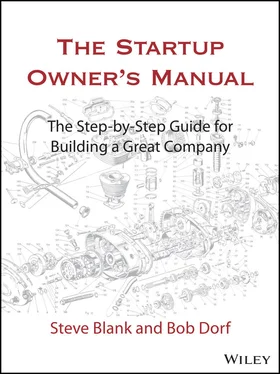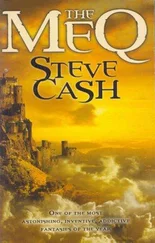Chapter 1:
The Path to Disaster:
A Startup Is Not a Small Version of a Big Company
Chapter 2:
The Path to the Epiphany:
The Customer Development Model
The Customer Development Manifesto
CHAPTER 1 The Path to Disaster: A Startup Is Not a Small Version of a Big Company
The definition of insanity is doing the same thing over and over and expecting different results.
—Albert Einstein
WHILE THIS STORY IS OLD, ITS LESSONS are timeless. In the heyday of the dot-com bubble at the end of the 20 thcentury, Webvan stood out as one of the most electrifying new startups, with an idea that would potentially touch every household in America. Raising one of the largest financial war chests ever seen (more than $800 million), the company aimed to revolutionize the $450 billion retail grocery business with online ordering and same-day door-to-door grocery delivery. Webvan believed this was one of the first “killer applications” for the Internet. Customers could just point, click, and order. Webvan’s CEO told Forbes magazine that Webvan would “set the rules for the largest consumer sector in the economy.”
Beyond amassing megabucks, the Webvan entrepreneurs seemed to do everything right. Backed by experienced venture-capital investors, the company raced to build vast automated warehouses and bought fleets of delivery trucks while building an easy-to-use website. Webvan hired a seasoned CEO from the consulting industry. What’s more, most initial customers actually liked the service. But barely 24 months after the initial public offering, Webvan was bankrupt and out of business. What happened?
…barely 24 months after the initial public offering, Webvan was bankrupt.
This was not a failure of execution. Webvan did everything its board and investors asked. In particular, the company fervently followed the traditional new-product introduction model commonly used by most new ventures and embraced the mantras of the time: “first mover advantage” and “get big fast.” Webvan’s failure to ask “where are the customers?” illuminates how this tried-and-true model led one of the best-funded startups of all time down the path to disaster.
The Traditional New-Product Introduction Model
In the 20th century, every company bringing a new product to market used some form of product management model ( Figure 1.1). Emerging early in the century, this product-centric model described a process that evolved in manufacturing industries. The consumer packaged-goods industry adopted it in the 1950s, and it spread to the technology business in the last quarter of the century. There it became an integral part of the startup culture.

Figure 1.1 New Product Introduction Diagram
At first glance, the new-product introduction model outlined in the diagram at right appears to be helpful and benign. It illustrates the process of getting a new product into the hands of waiting customers. A new product moves from development to customer testing (alpha/beta test), and using feedback from this initial testing, the product engineers fix technical errors in the product until the product launch date and first customer ship.
The new-product introduction model is a good fit for an existing company where the customers are known, the product features can be spec’ed upfront, the market is well-defined, and the basis of competition is understood.
As for startups, a scant few fit these criteria. Few even know who their customers are. Yet many persist in using the new-product introduction model not only to manage product development but as a roadmap for finding customers and setting the timing for the startup’s sales, launch and revenue plans. Investors use the new-product introduction diagram to set and plan funding. All parties involved in the startup use a roadmap leading toward a very different location, yet they’re surprised to end up lost.
What’s wrong with the old model, and how did it contribute to the billion-dollar Webvan implosion?
At the concept and seed stage, founders capture their passion and vision for the company, sometimes on the back of a napkin, and turn them into a set of key ideas, which becomes the outline for the business plan.
Next, issues surrounding the product are defined. What is the product or service concept? What are the product features and benefits? Can it be built? Is further technical research needed? Who will the customers be, and where will they be found? Statistical and market research and a few customer interviews fuel the evaluation and business plan.
This step also brings forth a first guess at how the product will ultimately reach the customer, including discussions of competitive differences, distribution channels, and costs. An initial positioning chart explains the company and its benefits to venture capitalists or corporate higher-ups. The business plan now gets market-size, competitive and financial sections, with an appendix containing Excel spreadsheets forecasting revenue and expenses. Creative writing, passion and shoe leather combine in the concept and seed phase in hopes of convincing an investor to fund the company or the new division.
Once a waterfall process starts, the proverbial train has left the station…
Webvan did all of this extremely well. Founded in December 1996, with a compelling story and a founder with a track record, Webvan raised $10 million from leading Silicon Valley venture capitalists in 1997. In the next two years, additional private rounds totaling an unbelievable $393 million followed before the company’s IPO.
In stage two, product development, everyone stops talking and starts working. The respective departments go to their figurative corners as the company begins to specialize by function. Marketing refines the size of the market defined in the business plan and begins to target the first customers. In a well-organized startup (one with a fondness for process), the marketing folk might even run a focus group or two on the market they think they’re in and work with Product Management on a market requirements document (MRD) for engineering to specify the product’s final features and functions. Marketing starts to build a sales demo, writes sales materials (websites, presentations, data sheets), and hires a pragency. In this stage, or by alpha test, the company traditionally hires a VP of Sales.
Meanwhile, Engineering focuses on specifying and then building the product. The simple box labeled “Product Development” typically expands into a “waterfall” or “spiral” or incremental process of interlacing steps, all focused on minimizing development risk of a defined feature set ( Figure 1.2). This process starts with the founder’s vision, which may be expanded into an MRD (and a product requirements document), and expands further into detailed engineering specifications. With those in hand, Engineering begins implementation fueled by cold pizza and long nights and weekends. Once a waterfall process starts, the proverbial train has left the station and the product is nearly impossible to revise. As a rule, the “train” can run almost nonstop for 18 or perhaps 24 months or more, uninterrupted by changes or new ideas no matter how good they might be for the business.

Figure 1.2 The Product Development “Waterfall” Model
Читать дальше













